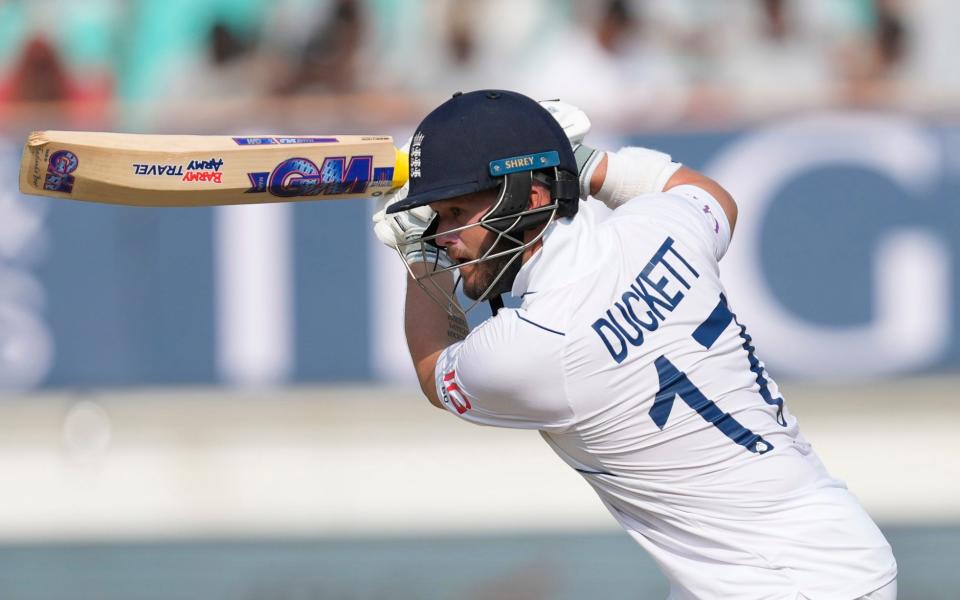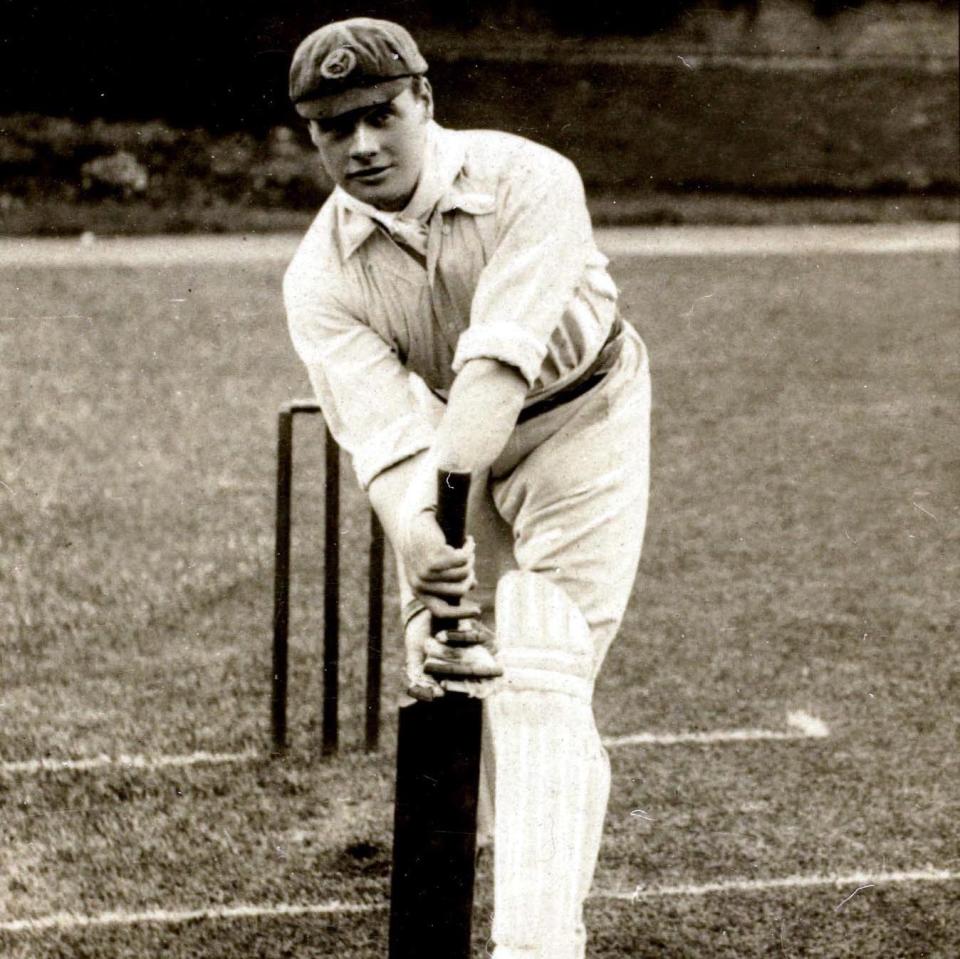England's Ben Duckett is a Test match opener sensation – and no one expected that

On his first tour of India, Ben Duckett was dropped for the third Test. Eight years later, he used the third Test to make a remarkable, redemptive century. It was a statement innings that cemented his status as a force to be feared in Test cricket.
Duckett reached stumps on 133 from 118 balls, having made 96 runs in boundaries, and 114 runs in the session. It was the fastest Test century by an Englishman in India, the second fastest by an England opener, and the third fastest by a visiting batsman in this country. Briefly, Gilbert Jessop’s 122-year-old record (click to read more below) for the fastest century by an Englishman was under threat again, but it was not to be.
More important than any record was that this was without doubt Duckett’s best innings for England, both in terms of skill shown and when he showed it. To score this quickly, against this attack, when so far behind in the game, having fielded for almost five sessions set this innings apart.
In 30 Test innings as an opener, Duckett now has an average of a whisker under 50.6, and a strike-rate of 89.6. No Test opener with 1,000 runs or more (he has 1,341) scores quicker. Next is Virender Sehwag (with a strike-rate of 83), with the likes of David Warner and Sanath Jayasuriya also trailing in Duckett’s wake. It is very early days, but only four England openers with 1,000 Test runs have done it at a better average (Herbert Sutcliffe, Len Hutton, Jack Hobbs and Dennis Amiss, who played most recently, in 1977).

For six years until 1 December 2022, when he returned to the England side with a bang, defying illness to score a century on an extraordinary day in Rawalpindi, the idea of Duckett keeping this sort of company, of stacking up these sorts of numbers, seemed utterly fanciful.
Duckett turned 22 on the 2016 tour. He had earned selection as a county thrasher, famed for making mincemeat of Division Two dibbly-dobblers for unfashionable Northamptonshire.
It was clear that he had a higher ceiling than that, but everything about his first Test tour, to Bangladesh then India, was a culture shock. Demoted to No 4 to accommodate the prodigal Haseeb Hameed, he struggled badly with Ashwin, who dismissed him three times in three innings as Duckett averaged six. He struggled also with the team’s staid approach; captain Alastair Cook told him to block for a draw in Vizag, and he made a 16-ball duck and was duly dropped. The step-up from county to Test cricket in terms of the professionalism demanded of players proved a struggle, too. He was a young man who had lacked discipline off the field, and it showed.
Having had a taste of Test cricket, Duckett was banished back to the boondocks. He moved county and moved to No 3. The runs never stopped flowing but, for a while, nor did the little lapses in discipline that blighted him as a youth.
It should be little surprise that it was this England setup – who value stroke-making on the field, and having fun off it – that recalled him, and little surprise that it is in this England setup that he has finally found his feet at Test level. At 28, with 10 years in the professional game behind him, he returned a more mature character and rounded cricketer.
Inspired move from England to reinstate Duckett at top of order
His partnership with Zak Crawley is easily England’s best since Cook and Andrew Strauss. Until Friday, Rory Burns and Dom Sibley – who were diametrically opposite in approach to Crawley and Duckett – had opened together more than any other pair since the two Sirs separated in 2012. Crawley and Duckett matches that tally here, and have scored 1,262 runs together at an average of 50.5, compared to Burns and Sibley’s 734 at 28.2.
The last time England were in India, in 2021, Burns and Sibley were the preferred opening pair. Crawley was in the squad, struggling for an identity, but Duckett was nowhere to be seen, a career as a white-ball swisher looming. He was hiding in plain sight, but England were not brave enough to pick him. Reinstating him at the top of the order, especially alongside Crawley, was an inspired piece of selection from England. The emergence of a stable opening pair was one of the final pieces of the jigsaw for England under Brendon McCullum, but now it is arguably the most transformed part of the team.
Crawley contributed just 15 of their stand of 89 here, so dominant was Duckett. They have not had a bumper partnership this tour, with that being the biggest, but the smallest is only 45, showing their unlikely, new-found consistency.
The glamour of Crawley’s strokeplay and the striking nature of his statement moments – think Old Trafford, or hitting the first ball of the Ashes for four – can disguise the fact that Duckett is really Bazball’s standard-bearer any the top of the order. Only Harry Brook has a higher average than him under McCullum, and no batsman has a higher strike-rate. With Brook absent, only Joe Root has a higher career average in this team.
A measure of Duckett’s development, and the quality of this innings, was the approval of his scourge Ashwin, who has caused him so many sleepless nights over the last eight years.

Ashwin pointed out that Duckett had 55 by the time he was brought into the attack (a curious bit of captaincy from Rohit Sharma), but added: “A couple of the shots he hit, especially the slog sweeps, were really special. Ben Duckett is a phenomenal talent so credit to him, he’s made a wonderful hundred today. I wanted to clap, but the hardcore competitor in me didn’t allow me to clap, but I’m very happy for Ben.”
Duckett has joked often about Ashwin’s hold over him, and they briefly played together at Nottinghamshire. But for Duckett, there might be no higher praise than that.
England’s Bazballers are constantly breaking records - bar one
It is amazing how his record survives 122 years on. Most records of human endeavour keep on being surpassed but not Gilbert Jessop’s century off 76 balls against Australia in 1902. It remains, even in the Bazball era, England’s fastest Test hundred.
Many congratulations will be bestowed on the head or helmet of the England batsman that breaks Jessop’s record, and rightly. It should not only be defensive England openers that receive knighthoods.

But congratulations too, I say, to England’s current Test batsmen for NOT breaking it yet. And that has nothing to do with deference to Jessop, “The Croucher”, and his batting style that was more than a century ahead of its time and a foretaste of T20 hitting.
In the present England dressing-room they are well aware of Jessop’s record, and what they have done commendably is not to have prioritised the breaking of it. It will come naturally, in time, this summer probably, and meanwhile their batsmen have responded to what matters most, the game-situation they have found themselves in.
We can recall a couple of recent Tests which England have thrown away when one of their younger batsmen has become too giddy: Zak Crawley when he was motoring in the second Test of this series, and when Ollie Pope let Australia back in at Lord’s last year after Nathan Lyon had limped off. Joe Root too has given his wicket away by over-attacking spinners. But overall England’s batsmen are striking the right note of aggression and not trying to motor in sixth gear all the time. This is a terrific achievement in itself - more important than record-breaking - to have adapted to a style of Test cricket which has never been tried before, except by Jessop.
Thus Ben Duckett reached his dazzlingly brilliant 50 off 39 balls in Rajkot. So did Jessop at the Oval in 1902. But Duckett did not accelerate for the record, he reined himself in a touch for the sake of his team, and even respected Ravichandran Ashwin when he was belatedly brought on, and played a few defensive shots, before taking apart the new 500-wicket champion with his slog-sweeps.
Do not arrive late if you have booked tickets for a day of the three-Test series against West Indies and Sri Lanka in the second half of next summer. Duckett or Crawley are the likeliest to knock Jessop off his perch, simply because they will have first dibs, but Harry Brook and Jonny Bairstow will not be far behind. Bairstow indeed has come the closest yet, needing 77 balls for his Trent Bridge target-chasing hundred against New Zealand which set the tone of the Stokes-McCullum era, wherein anything is possible so long as one dares and practises for it.
Sooner or later Test attacks will try to play on Duckett’s patience and hang the ball well outside off stump - as far as they can without being called for a wide - and on a full length (anything else he can cut). He wants to get his bat on every ball, but if it is slanting across and going wider, with an old-time Carmody field of five or six slips, will he be able to resist and let it go past? Yes, provided he is not intent on Jessop’s record.
If there is a single reason why Jessop’s record still stands it is because he had the licence to hit fearlessly and without fear of any consequences - exactly what England’s batsmen do now, but the opposite of what they were ever allowed to do between Jessop’s innings and the Bazball era.

When Jessop went in at number seven, England were 48 for five, chasing 263 to win. The last specialist batsman was at the other end, and conventional methods were not working. Not surprisingly: the pitch had been rained on earlier that same day and had been cut up by the traffic of feet. None of England’s current players would have batted on anything remotely similar, except perhaps at Under-11 level when the groundsman had not bothered to put the covers on.
Jessop’s response, in the last ditch, was to hit as he always did. His secret lies in his pseudonym: he crouched, and got under the ball to launch it aerially, as Duckett does when he sweeps and slog-sweeps and reverse-sweeps, but as no other batsman did then. It was the English batsman’s duty to stand tall at the crease, and let his front elbow lead him into the shot, and to play with a straight bat - Edwardian customs which lasted till now.
Actually, when Jessop recalled his innings, he wrote about the feature of which he was most proud. The Australian tourists were Aussies, even in those days, and had called Jessop to his face a slogger, nothing more. And his Test record was ordinary overall, his average 21, and this his only hundred.
So Jessop in retrospect was proud to observe that he had not slogged - I think we would say he neither swept nor slog-swept - Australia’s most dangerous bowler, Hugh Trumble, who bowled quick off-breaks, the ideal method for a wet pitch.
“I had neither a three nor a boundary against that bowler on the leg side,” Jessop wrote. “I had kept to that resolve throughout, even carrying it to excess, for against Trumble when I received one or two balls on the leg stump simply “asking for it”, I smothered my greed and contented myself with a single.”
Jessop still drove several balls into the Oval pavilion, only they were counted as four not six then (it had to go out of the ground until 1910). He also pulled by all accounts, and he cut straight balls off the stumps. And when he was out for 104, a match-winning innings even if the margin was only one wicket, the Australians joined in the applause of a packed Oval crowd of 22,000 “most heartily.”

 Yahoo Sport
Yahoo Sport 





































